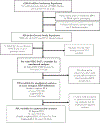Genetic Susceptibility to Postdiarrheal Hemolytic-Uremic Syndrome After Shiga Toxin-Producing Escherichia coli Infection: A Centers for Disease Control and Prevention FoodNet Study
- PMID: 29216383
- PMCID: PMC11318523
- DOI: 10.1093/infdis/jix633
Genetic Susceptibility to Postdiarrheal Hemolytic-Uremic Syndrome After Shiga Toxin-Producing Escherichia coli Infection: A Centers for Disease Control and Prevention FoodNet Study
Abstract
Background: Postdiarrheal hemolytic-uremic syndrome (D+HUS) following Shiga toxin-producing Escherichia coli (STEC) infection is a serious condition lacking specific treatment. Host immune dysregulation and genetic susceptibility to complement hyperactivation are implicated in non-STEC-related HUS. However, genetic susceptibility to D+HUS remains largely uncharacterized.
Methods: Patients with culture-confirmed STEC diarrhea, identified through the Centers for Disease Control and Prevention FoodNet surveillance system (2007-2012), were serotyped and classified by laboratory and/or clinical criteria as having suspected, probable, or confirmed D+HUS or as controls and underwent genotyping at 200 loci linked to nondiarrheal HUS or similar pathologies. Genetic associations with D+HUS were explored by multivariable regression, with adjustment for known risk factors.
Results: Of 641 enrollees with STEC O157:H7, 80 had suspected D+HUS (41 with probable and 32 with confirmed D+HUS). Twelve genes related to cytokine signaling, complement pathways, platelet function, pathogen recognition, iron transport, and endothelial function were associated with D+HUS in multivariable-adjusted analyses (P ≤ .05). Of 12 significant single-nucleotide polymorphisms (SNPs), 5 were associated with all levels of D+HUS (intergenic SNP rs10874639, TFRC rs3804141, EDN1 rs5370, GP1BA rs121908064, and B2M rs16966334), and 7 SNPs (6 non-complement related) were associated with confirmed D+HUS (all P < .05).
Conclusions: Polymorphisms in many non-complement-related genes may contribute to D+HUS susceptibility. These results require replication, but they suggest novel therapeutic targets in patients with D+HUS.
© The Author(s) 2017. Published by Oxford University Press for the Infectious Diseases Society of America. All rights reserved. For permissions, e-mail: journals.permissions@oup.com.
Conflict of interest statement
Figures


References
-
- Mele C, Remuzzi G, Noris M. Hemolytic uremic syndrome. Semin Immunopathol 2014; 36:399–420. - PubMed
-
- Smith JL, Fratamico PM, Gunther NW 4th. Shiga toxin-producing Escherichia coli. Adv Appl Microbiol 2014; 86:145–97. - PubMed
-
- Hale CR, Scallan E, Cronquist AB, et al. Estimates of enteric illness attributable to contact with animals and their environments in the United States. Clin Infect Dis 2012; 54(Suppl 5):S472–9. - PubMed
-
- Bryan A, Youngster I, McAdam AJ. Shiga Toxin Producing Escherichia coli. Clin Lab Med 2015; 35:247–72. - PubMed
-
- Crim SM, Griffin PM, Tauxe R, et al.; Centers for Disease Control and Prevention (CDC). Preliminary incidence and trends of infection with pathogens transmitted commonly through food - Foodborne Diseases Active Surveillance Network, 10 U.S. sites, 2006–2014. MMWR Morb Mortal Wkly Rep 2015; 64:495–9. - PMC - PubMed
Publication types
MeSH terms
Grants and funding
LinkOut - more resources
Full Text Sources
Other Literature Sources
Medical
Research Materials
Miscellaneous

